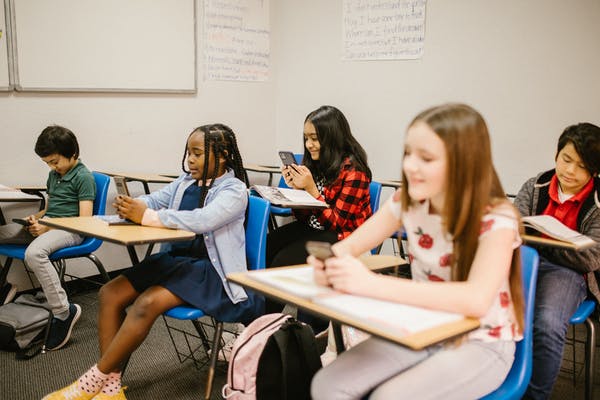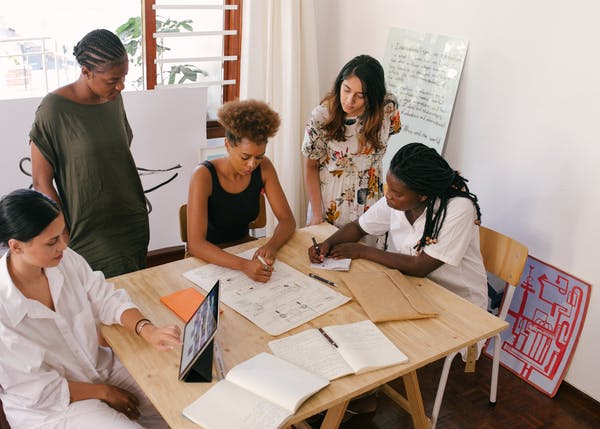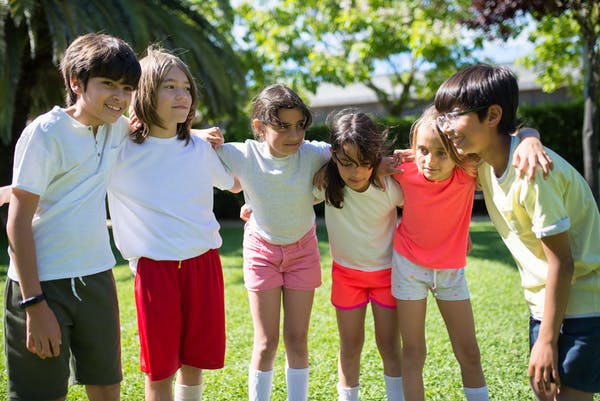May 10, 2022
Debate 1: Technology does not enhance learning
This debate was somewhat challenging for me because technology is integrated through all of my classes and if I was not debating this side I would disagree with it. I use Google Classroom and the Google suite of applications on a daily basis. All of my students create a website as an online portfolio of their work. I use Edsby for marks and attendance. Students use their personal devices for vocabulary building, online games and activities. I use language software such as Duolingo to help my students learn vocabulary. With all the advantages, there are a lot of challenges that come with technology in the classroom. I find my students are easily distracted by notifications, games and other apps but they need to learn how to manage this on a daily basis. I spend a lot of classroom management time telling my students to shut down their games and social media accounts. The tech is here to stay and there are a lot of benefits if used correctly. More time needs to be spent teaching students how to use it responsibly.
Teachers today seem to be overloaded with emails and the time spent managing and replying to emails is growing every year. I could spend most of my daily prep period managing my inbox. The number of emails in my inbox is partially my fault because I need to spend some time unsubscribing to older email feeds. I was an international student coordinator from 2006-2013 and I still find myself deleting emails from this position when I should be looking for the unsubscribe link. Students can now use Edsby to direct message questions. Although this can be a good way to get some clarification on an assignment or mark, the questions are often ones that can be asked in class. Teachers often email all of the things that are not necessary and this kind of email clutter can cause you to miss important messages.

Access to Technology in our school is not equal. It differs from class to class in terms of the tech the students have access to personally. Some students just don’t have access to tech until they get a job and buy it themselves. Within the school technology can differ from lab to lab. At Winston Knoll, some computer labs have newer hard drives and software updates while others lag behind. The amount of time students spend signing into older tech can be a real detriment to their learning. Have had students wait 15 minutes just to sign into a terminal. When it works well it can enhance learning but when it doesn’t it can create stress and frustration.
Teachers also need more professional development in the area of technology. Much of the time we are expected to know or learn things on our own. It can be overwhelming to change to a new tech platform or try to learn these new systems.
I agree with the other team when they said that some students are dependent on technology I agree with the other team when they said that some students are dependent on technology to be successful. Students with a sight or hearing impairment benefit greatly from the technology in the classroom. Students with physical and mental challenges also have access to technology that helps them to be successful.
Debate #2: Technology brings greater equity to society.
This was a challenging debate for both sides and both teams did a great job to defend their positions. When discussing how technology brings greater equity in society it is a constant struggle between the tech companies who are trying to make a profit off and governments, open source organizations, non profits, NGO’s and Educational institutions who are trying to improve access technology to society.
Technology does a lot to enhance learning in the classroom. It allows students greater access to information, creates more connections with other students and teachers. It can facilitate feedback and teacher student communication. It allows for tools of greater engagement with students who are already engaged with online games and social media.
Special needs is one area where technology does bring great equity to society. In Canada, schools have access to technology to help students with a wide range of needs. At Winston Knoll we have a Deaf and Hard of Hearing Program. (DHH) Students have access to hearing aids and teachers have access to broadcast devices to allow some students to hear the lectures. We also have functional integrated academic programs (FIAP) where students use a wide range of technology to help support their development. Technology can bring greater equity to our special needs students within the public school system.
In Canada, there is a lot of technological inequity within our society. Depending on where you live access can be less than people living in urban areas. Northern communities are especially isolated when it comes to access to technology. Rural areas are continuing to improve internet connectability. Governments are working on these inequities and technology is always improving to help connect even the most remote communities. Elon Musk’s Star Link is an example of that but again it is only available to those who can pay.
Globally the situation is worse for many less developed countries where governments and school boards just do not have the money to buy and support technology. These technological inequities are based both in geography as well as economics.
The richest companies on the planet are all technology companies. They are all in business to make a profit which means only people with the means to purchase have access. Staying up to date with the latest tech is almost impossible unless you have the income to support these purchases. Access to new technology will be more difficult for the poor. Some NGO’s are supplying hardware to 3rd world countries such as the 1 laptop per student program in Ethiopia. In a way this is a new form of digital colonialism. We are flooding the third world with old technology and will their students actually learn and benefit from this.
students who received a laptop during the pandemic only to pawn it for money speaks volumes of some of the needs of families in our community schools.
Disinformation, bias, fake news and propaganda are all problems in today’s online world. It has become very easy to be wrapped up in streams of disinformation as algorithms link people with sites that support their own views. The pandemic, elections, and the Canadian freedom movement have brought these issues to the forefront. This creates even more inequities in society as people with less education fall prey to conspiracy theories, fake news and disinformation.
Inequities exist as well among different generations of teachers. Younger professionals who have grown up with social media and access to technology have an advantage over older generations who have not had the same exposure. We see this among staff who were resistant to online learning during the pandemic or feel the professional development opportunities regarding technology would not be a benefit.
Debate #3 Schools should no longer teach skills that are easily carried out by tech.
I disagreed with this statement before and after the debate. I am not sure if it is my age but in this case, I need to “hold onto the past” and there is scientific evidence to back that up. Skills that are easily carried out by tech are just good for the overall brain development of young students and provide the basis for further learning.

I teach Core French and also have a 4 year old child who is currently learning English and will soon begin his second language development in kindergarten. It’s been my experience that the more ways you can think about and input something into your brain the better off you will be to remember that knowledge. Cursive writing increases the ability to remember information. When I teach vocabulary in French I use full contextual sentence structure. Students write it in their books with translations off the board, which inputs that information into one part of the brain. Students then type that sentence into a doc using another part of the brain. Finally students create a web page using that information with other visual cues. Over the years I have found that this type of basic repetition on both a digital and cursive writing level helps my students better remember the vocabulary.

Memorizing a verb conjugation or times table helps them to take that information and use the same sentence with other subject situations. When I studied French in high school, I remember more emphasis being put on conjugations and less on the connections with real world communication. As a student of the 70’s and 80’s I was forced to learn my times tables in class. I feel this has helped me in some situations but not vital day living with the access to technology that we have. As I write this spell check I corrected 4 or 5 words that I misspelled as I quickly try to record my thoughts on this. It must be a balance and both sides of the debate have their place in modern education.

I lived in Africa and remember traveling through rural areas and kids would have their arms stretched making a motion with their hands as I drove by. I later learned that they were making a writing motion hoping that you would toss a pen or pencil out the window. I also learned that some rural schools did not allow a student in the class if they did not have a writing utensil.


In 1996 I worked for Roots and Shoots Africa with the Jane Goodall Institute on an environmental initiative with local schools in Dar es Salaam. This was my first introduction to the 3rd world and the digital divide.
There is a digital divide in the first world but in much of the 3rd world the access to technology just does not exist. One other thing I have from my time in Africa are my travel journals written in my hand. It was a snapshot of my life and the written word on paper gives it life. As I read them now, seeing the wrinkled pages, beer splatters and other signs of my life back then, it just seems more real than if I would have typed it on my laptop.
Cursive writing has been linked to student comprehension and retention. It is one more way to enter information into the brain and with each comes higher comprehension and retention through repetition. I said before that I use this strategy with language learning. Write it down, enter it into a doc, create a webpage. The repetition of this strategy helps my students to internalize the information.

When I look at my son, I now find myself always asking the question: what would I want for him? I would like him to understand how to write and do basic math without a calculator as well as understand how to use it. I know he will have access to technology but I believe that internalizing these basic skills will help him in the long run. This discussion has actually motivated me to spend more time helping him to learn how to write with a pencil in hand.
Technology is not going away and will be ever improving for teachers and students. Basic skills need to be developed alongside traditional skills. There is still a great need for these in everyday life even though you have a smart phone to help you at every step of the way.
Debate #4 Technology should be used to promote social justice
At the initial vote on this debate, I thought that technology would be a good platform to carry out the pursuit of social justice and agreed with this statement. It seems like a good place to promote social justice, a place where many people have access and the same rights. A place for responsible digital citizenship where people can teach each other about social justice in our society. I imagined some of my marginalized students using technology to teach others about their challenges and their personal social justice challenges.

As the debate went on I realized that technology might not be the best platform to voice one’s cause. In our breakout room discussion we discussed the rural urban divide in our province and that many things that could be voiced in larger urban areas may not go over as well in smaller more conservative towns. It may be better to have these conversations face to face where you can properly respond. As a teacher, one needs to consider how some members of the community might react both for online backlash and in extreme cases personal safety.
Personally, I use teachable moments in the classroom to discuss social justice issues allowing students to debate the issues and share personal stories in a much safer environment. Other comments were made about teaching in religious based schools where certain views are contrary to the teachings of their religion. In these situations our views can have a direct impact on our jobs and if we have chosen to take a job in those schools then we must act accordingly.
Online views are easily shut down or ignored. The word “slacktivism” was brought up a number of times during the debate. It’s easier to be a keyboard warrior than actually leaving the house and joining a rally or organized event. I feel we don’t truly understand our sphere of influence online and generally like minded people follow each other through their social media accounts. I deleted a number of people during the pandemic because of their views on science and vaccination but I am sure they found an audience and support somewhere else.

It’s clear that social media education is something that needs to be properly developed in primary and secondary curriculums. More discussion is needed in how technology should advance social justice online and teachers need to keep in mind how administration and society in general will respond to one’s activism.
Debate #5 Social media is ruining childhood
At the outset of this debate I agreed with this statement but as I listened, I changed my mind. I agree that overindulgence in social media can have effects on the user. The “agree” side noted that reduced attention spans, problems with memory retention, robbing children of an authentic life, more direct access to advertising and the possibility of online predators was having a great impact on children on our society. It was unclear what age cohorts the data was taken from.

Many parents just do not allow access to social media at a young age. Those that do may have parents or older siblings who are using social media and including the younger ones. I found the kindergarten story about students using YouTube and showing each other offensive material to be worrisome. I would like to know if this exposure to YouTube was from their parents or older siblings or was it due to their own personal online explorations? There must be an effect on younger siblings who copy their older brothers and sisters. A lot of parents are also guilty of overindulging in social media and this must be having a direct impact on their children.

When I look back on my childhood I definitely find myself romanticizing the positive aspects and sweeping away the negative. Randi Zukerberg in her Article, “Kid Complicated: Childhood Isn’t What It Used to Be”, as a young person she lived in two worlds: the real world and imaginary world and today we have entered a third world of online connectivity. My son at 4 already has skill that I never had when I was that age. He can already navigate a smart phone to find an educational game or song app. Zukerberg goes on to say that this 3rd world can be “a whole new dimension of creativity, education, and delight. But when used mindlessly or as a default, we run the risk of this new virtual world creeping into the time kids would have spent using their own imagination and creativity.” As parents and educators we need to be mindful of this and be constantly adjusting our use of technology so not to fall into this trap.
The “against” side looked at the advantages of social media to connect people, share personal experiences, and gain mutual understanding. Do children need to connect with a greater community? Neighbors, sports teams and community parks was all I had growing up. They did not disagree with the fact that social media needs to be monitored by parents or guardians. I needed to see more information regarding the age in which students engage and how much time is spent on social media sites but I cannot see this being popular until the tween and teen years.

I think it is definitely more of an issue at the high school level. I would say that snap chat is the most popular social media tool of teens and it is highly distracting to their attention in class. In the end there was not enough evidence to say that it ruins childhood. My son just doesn’t have the interest in social media that a 13+ year old would have.
Debate #6 Cell phones should be banned in classroom
Cell phones should not be banned in classrooms. These devices are one more tool a teacher can use but there must be education to help students use these tools responsibly. I use personal cell phones in all of my classes. Students access Duolingo and learn French vocabulary on a daily basis. My photography students use online editing apps to improve their images. Since Regina Public schools lost its access to the internet due to a data breach, personal cell phones have even become more important as a classroom tool. Personal phones are also used to create video content and voice recordings in my French classes.

These devices will not go away after high school so learning how to responsibly use them in class can also translate to the real world after graduation. Unchecked they can become a distraction. Its easy to default to game mode when the teacher or parent isn’t looking. Responsible use at home and in the workplace is also needed.
The disagree side cited safety and communication with parents being an advantage. The debate on this was interesting because school boards often try to limit communication during an incident so as to release proper and timely information. As a parent I would want immediate communication with my child in case of an emergency. The recent school shootings in Uvalde Texas there were multiple 911 calls from inside the school but communication between dispatch and the police was not getting through. This is an unthinkable situation but in a situation like this I would like to be able to call my son and ensure his safety.
Kimberly Kipp had an interesting story about the meme against a sub in her school. It was unfortunate but this is a problem that could occur anywhere today. In the past this would have writing on the bathroom wall or a doodle on paper. I think this is a fairly rare occurrence but I may be wrong. Maybe its more prevalent at the elementary level. I am sure teachers are captured in snapchat photos on a daily basis and we just don’t know about it. Again proper education is needed for students to understand the effects of their actions on staff and other students.

There was another interesting comment on our carbon footprint from smart phone devices. As the world becomes more and more connected this problem will grow. Having inconsistent rules on smart phones in the classroom from board to board and country to country. Again all we can do is educate people and hope that they change their habits a little to help the environment.

I have a love hate relationship with smart phones in my classroom. It is a constant battle to keep students in line but it is one of the realities of teaching today. If we are going to prepare students for a digital future we as educators must teach our students to responsibly use this technology in the classroom. In the future they will need to responsibly use their cellphones in their careers.
Debate #7 Educators and schools have a responsibility to help their students develop a digital footprint.
At the start of this debate, I voted to agree with this statement. I equated a digital footprint with digital citizenship and prior to this debate did not really separate the two. I now understand that your digital footprint is the culmination of any digital activity you have engaged in online over time and this can be either positive or negative depending on the type of activity one is engaged in. In theory it is a good idea to help students develop a positive footprint online but when does this actually happen. It was discussed that there are many curriculum connections to identity but nothing that deals directly with a digital footprint. Curriculums are outdated and playing catch up. Teachers are left to interpret what they think is most important and the ones who are more digitally savvy may actually spend time on this topic.
I have been teaching for almost 20 years, which is an alignment of the growth of computer science and online education in the classroom. The idea of being conscious of one’s digital footprint is a relatively new idea. It has only been in the last 10 years that this has become an important consideration. Teachers need to discuss the idea of good digital citizenship with their students to build their students knowledge to help them develop a positive digital footprint.

The disagree side mentioned that students already have a developed digital footprint when they enter school. I would argue that this is different for every student and it would depend greatly on the social media use of parents and older siblings. The digital divide would also play a role here. I agree that is a reactive model to digital footprints that are negative due to shared inappropriate photos or negative online behavior such as harassment or bullying. How do educators control this environment? It needs to be a shared responsibility between parents, teachers, tech companies and lawmakers. The problems seem to be pushed down the line but there needs to be more accountability from the tech companies themselves.

At Winston Knoll we are given a 1 page Tech Agreement that discusses online citizenship and proper behaviour. Some teachers may take the time to go over this while others just send it home for the parents to sign. More time needs to be spent on this at the beginning of the year.
In the end I changed my mind and disagreed with the statement. As educators it’s our responsibility to educate and give guidance to students about the world around them. A lot of this comes from our own personal experiences. Most teachers do not have the background or education to properly educate students on how to develop a digital footprint. Until this become a priority in the curriculum and money is spent on proper professional development it will not be our responsibility to develop our student’s digital footprint.
Debate #8 Online education is detrimental to the social and academic development of children.
This was our last debate and it was a spirited battle! The “agree” team argued that online education cannot replace good teachers in brick and mortar schools. The digital divide and overall accessibility to online learning was again discussed. Some student can fall between the crack or and widen the education gap between the have’s and the have not’s. Primary grade outcomes and overall student socialization is best done in a classroom setting where teachers can observe interactions and have face to face conversations with students. Some students who need extra support would not be able to achieve success in the online setting.

Student online stress and anxiety is on the increase and this is fostering isolation and problems with a lack of motivation. It was noted that bullying within the walls of the school does not disappear online and in certain situations can even be worse. We just do not have the data to support online learning at this time. Increased screen time is also a problem. Students are spending too much time gaming and engaging in social media and with added online education daily screen time could exceed 10-12 hours.

This takes away from physical play time, outdoor experiences and physical interactions with the world around them which can have a detrimental effect on their mental and physical well being.
The “disagree” team argued that online education was forced upon us during the pandemic lockdowns but now has become a supplement to the educational options that students have today. Some students with physical disabilities have greater access to learning opportunities. Students pick and choose whether the classroom or online options are best for them. I have some students who take a hybrid approach and take some online classes not offered at our school.

It was also noted that some rural students benefit from this when some elective courses are not offered at their school. As rural populations decline this will become more popular with students and administrations who cannot afford to bring in more teachers.

When students choose online learning it doesn’t mean they do not have access to extracurricular activities. Students can still play sports and be involved at the club level. Another point was made regarding homeschooling and that many students in this environment go on to be successful in post secondary education.
In the end I disagreed with this statement although both sides had some good arguments. It offers more students more opportunities but at the same time cannot be a blanket approach to the education system as a whole. Some student benefit greatly while other need to support of a teacher in a classroom.
